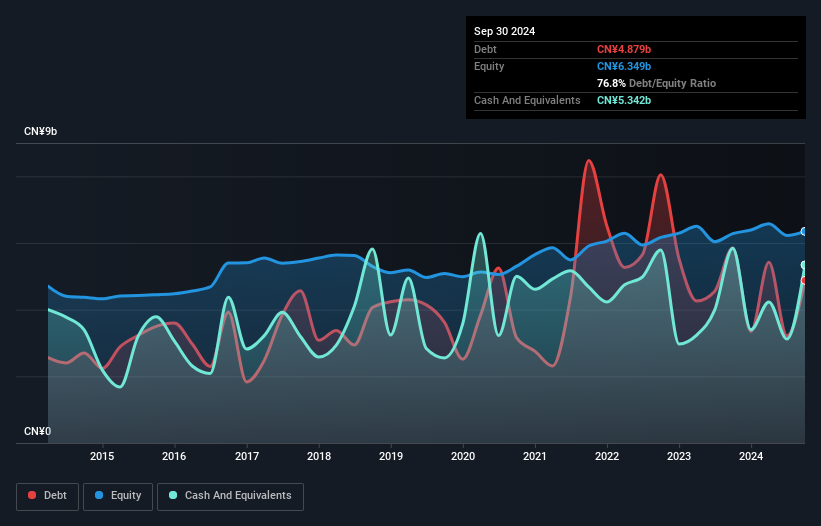- China
- /
- Electronic Equipment and Components
- /
- SZSE:002416
These 4 Measures Indicate That Shenzhen Aisidi (SZSE:002416) Is Using Debt Reasonably Well
Legendary fund manager Li Lu (who Charlie Munger backed) once said, 'The biggest investment risk is not the volatility of prices, but whether you will suffer a permanent loss of capital.' So it might be obvious that you need to consider debt, when you think about how risky any given stock is, because too much debt can sink a company. We can see that Shenzhen Aisidi Co., Ltd. (SZSE:002416) does use debt in its business. But should shareholders be worried about its use of debt?
Why Does Debt Bring Risk?
Generally speaking, debt only becomes a real problem when a company can't easily pay it off, either by raising capital or with its own cash flow. If things get really bad, the lenders can take control of the business. However, a more common (but still painful) scenario is that it has to raise new equity capital at a low price, thus permanently diluting shareholders. Of course, plenty of companies use debt to fund growth, without any negative consequences. The first thing to do when considering how much debt a business uses is to look at its cash and debt together.
Check out our latest analysis for Shenzhen Aisidi
What Is Shenzhen Aisidi's Net Debt?
As you can see below, Shenzhen Aisidi had CN¥4.88b of debt at September 2024, down from CN¥5.85b a year prior. But on the other hand it also has CN¥5.34b in cash, leading to a CN¥463.3m net cash position.

How Strong Is Shenzhen Aisidi's Balance Sheet?
According to the last reported balance sheet, Shenzhen Aisidi had liabilities of CN¥9.16b due within 12 months, and liabilities of CN¥40.7m due beyond 12 months. Offsetting these obligations, it had cash of CN¥5.34b as well as receivables valued at CN¥2.16b due within 12 months. So its liabilities outweigh the sum of its cash and (near-term) receivables by CN¥1.69b.
Of course, Shenzhen Aisidi has a market capitalization of CN¥19.1b, so these liabilities are probably manageable. However, we do think it is worth keeping an eye on its balance sheet strength, as it may change over time. While it does have liabilities worth noting, Shenzhen Aisidi also has more cash than debt, so we're pretty confident it can manage its debt safely.
The modesty of its debt load may become crucial for Shenzhen Aisidi if management cannot prevent a repeat of the 24% cut to EBIT over the last year. When it comes to paying off debt, falling earnings are no more useful than sugary sodas are for your health. The balance sheet is clearly the area to focus on when you are analysing debt. But it is future earnings, more than anything, that will determine Shenzhen Aisidi's ability to maintain a healthy balance sheet going forward. So if you want to see what the professionals think, you might find this free report on analyst profit forecasts to be interesting.
Finally, a business needs free cash flow to pay off debt; accounting profits just don't cut it. While Shenzhen Aisidi has net cash on its balance sheet, it's still worth taking a look at its ability to convert earnings before interest and tax (EBIT) to free cash flow, to help us understand how quickly it is building (or eroding) that cash balance. Over the last three years, Shenzhen Aisidi actually produced more free cash flow than EBIT. There's nothing better than incoming cash when it comes to staying in your lenders' good graces.
Summing Up
We could understand if investors are concerned about Shenzhen Aisidi's liabilities, but we can be reassured by the fact it has has net cash of CN¥463.3m. And it impressed us with free cash flow of CN¥1.3b, being 216% of its EBIT. So we are not troubled with Shenzhen Aisidi's debt use. When analysing debt levels, the balance sheet is the obvious place to start. However, not all investment risk resides within the balance sheet - far from it. For example, we've discovered 3 warning signs for Shenzhen Aisidi that you should be aware of before investing here.
Of course, if you're the type of investor who prefers buying stocks without the burden of debt, then don't hesitate to discover our exclusive list of net cash growth stocks, today.
New: Manage All Your Stock Portfolios in One Place
We've created the ultimate portfolio companion for stock investors, and it's free.
• Connect an unlimited number of Portfolios and see your total in one currency
• Be alerted to new Warning Signs or Risks via email or mobile
• Track the Fair Value of your stocks
Have feedback on this article? Concerned about the content? Get in touch with us directly. Alternatively, email editorial-team (at) simplywallst.com.
This article by Simply Wall St is general in nature. We provide commentary based on historical data and analyst forecasts only using an unbiased methodology and our articles are not intended to be financial advice. It does not constitute a recommendation to buy or sell any stock, and does not take account of your objectives, or your financial situation. We aim to bring you long-term focused analysis driven by fundamental data. Note that our analysis may not factor in the latest price-sensitive company announcements or qualitative material. Simply Wall St has no position in any stocks mentioned.
About SZSE:002416
Shenzhen Aisidi
Provides digital distribution and retail services in China and internationally.
Flawless balance sheet and undervalued.
Market Insights
Community Narratives



